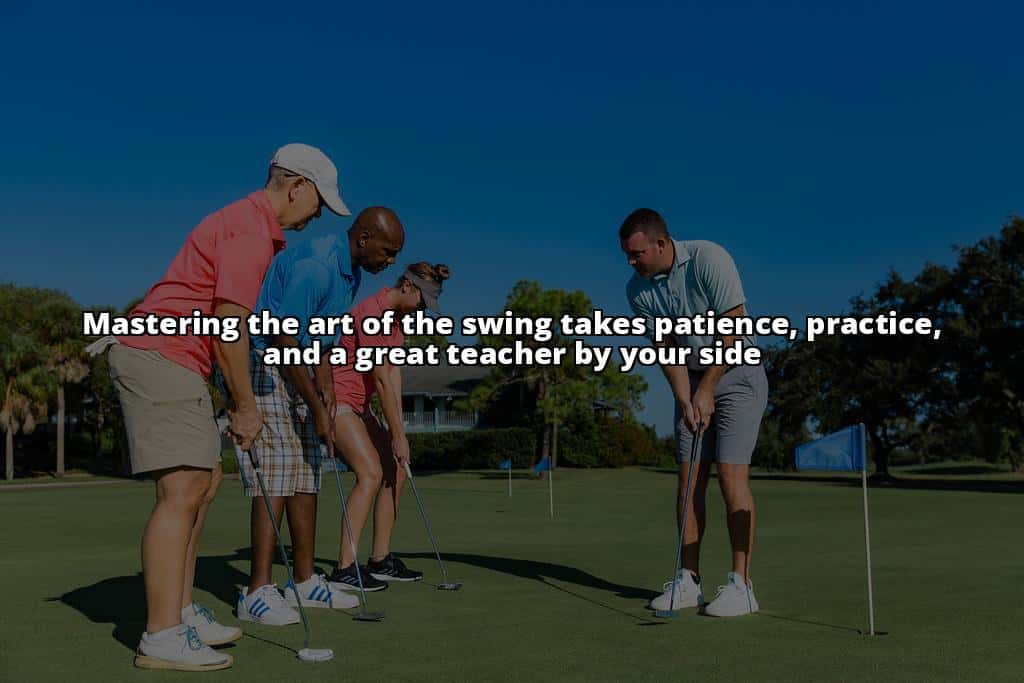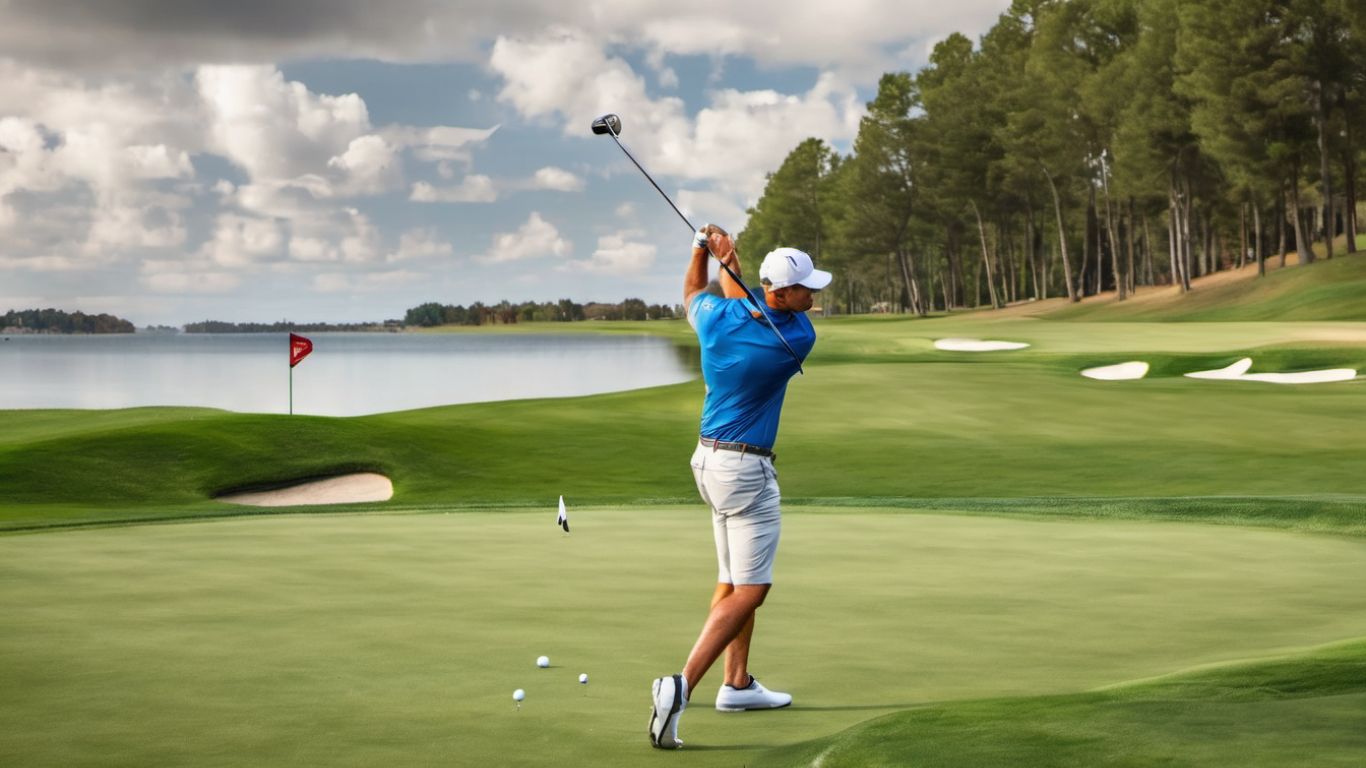To play golf, start by gripping the club with your dominant hand, then stand in front of the ball and swing smoothly. Golf is a popular sport enjoyed by people of all ages and skill levels.
Whether you’re a beginner wanting to learn the basics or an experienced player looking to refine your skills, mastering the game of golf requires practice, dedication, and knowledge of the fundamental techniques. In this guide, we will walk you through the essential aspects of playing golf, including the equipment needed, the basic rules and etiquette, as well as tips to improve your game.
By the end of this introduction, you will have a solid understanding of how to play golf and be ready to hit the greens with confidence.
The Fundamentals Of Golf
Golf is a sport that requires precision, skill, and focus. Understanding the fundamentals is crucial for anyone looking to improve their game. From grip and stance to proper club selection, mastering these basic elements sets the foundation for success on the green.
Grip And Stance
One of the most fundamental aspects of golf is the grip and stance. The grip refers to the way a player holds the club, and a proper grip ensures control and power. The stance involves the positioning of the body in relation to the ball, allowing for a consistent and effective swing.
Proper Club Selection
Choosing the right club for each shot is essential for success in golf. Proper club selection depends on factors such as distance, obstacles, and playing conditions. Understanding the characteristics of each club and when to use them is crucial for achieving optimal results on the course.

Credit: nationalgcla.com
Mastering Your Swing
Backswing Technique
1. Align your body with the target, with feet shoulder-width apart.
2. Keep your arms straight and begin to rotate your body, shifting your weight to the right foot.
3. Elevate the club smoothly, ensuring a 90-degree shoulder turn.
Downswing And Impact
1. Transition the weight to your left foot as you initiate the downswing.
2. Keep your arms close to your body, maintaining a consistent swing plane.
3. Focus on striking the ball with the clubface square to the target line.
Follow-through
1. Extend your arms fully post-impact, allowing the club to follow through naturally.
2. Rotate your body to face the target, maintaining balance and posture.
3. Ensure the club finishes high, with the grip pointing towards the target.
Developing Consistency
Learn how to play golf consistently by following these helpful tips and techniques. Improve your swing, focus on proper form and alignment, and practice regularly to develop consistency in your game.
Practice Drills
Training Aids
Developing consistency in your golf game is crucial if you want to see improvement and lower your scores. Whether you’re a beginner or a seasoned player, consistency is a skill that can always be worked on. In this section, we will explore two important aspects of developing consistency in golf: practice drills and training aids.
Practice Drills
One of the most effective ways to improve consistency in golf is through regular practice drills. These drills focus on specific aspects of your game and help you develop muscle memory and proper technique. Here are a few practice drills that can help you improve your consistency on the golf course: 1. Alignment Drill: Place two alignment rods on the ground parallel to each other, with enough space to swing your club between them. Practice hitting shots with the goal of keeping the clubhead traveling straight down the target line. This drill helps you develop proper alignment and ensures a consistent swing path. 2. Tempo Drill: Take a slow, deliberate backswing and then smoothly transition into your downswing and follow-through. Focus on maintaining a consistent rhythm and tempo throughout the swing. This drill helps improve your timing and prevents you from rushing or decelerating your swing. 3. Distance Control Drill: Set up a series of target flags or markers at various distances on the practice range. Practice hitting shots to each target, focusing on controlling your swing speed and club selection to consistently hit the desired distance. This drill helps you become more consistent in judging and executing shots of different lengths.
Training Aids
In addition to practice drills, training aids can be valuable tools in developing consistency in golf. These aids provide feedback and assist in addressing specific areas of your game that may need improvement. Here are a few training aids that can help you on your journey to consistency: 1. Swing Trainer: A swing trainer is a device that mimics the motion of a golf swing and helps you practice proper technique. It can assist in developing a consistent swing plane, tempo, and rhythm. 2. Putting Mat: A putting mat provides a flat, consistent surface to practice your putting stroke. It allows you to work on your alignment, stroke mechanics, and distance control, leading to more consistent putting on the course. 3. Impact Bag: An impact bag is a soft, weighted bag that you can strike with your club. It helps you focus on proper impact position and encourages a consistent and powerful strike. Remember, consistency in golf takes time and effort. By incorporating practice drills and training aids into your routine, you’ll be on your way to developing a more consistent game and seeing improvements in your scores. So, grab your clubs and start practicing to take your game to the next level!

Credit: swingproplus.com
Troubleshooting Common Swing Issues
One of the biggest challenges in golf is perfecting your swing. No matter how experienced you are, swing issues can occur and hinder your game. In this section, we will address two common swing problems that players face: the slice and hook, as well as the lack of distance. By understanding the causes and implementing the right techniques, you can overcome these challenges and improve your golf performance.
Slice
A slice is a shot that curves from left to right for right-handed players (opposite for left-handed players). It tends to ruin accuracy and distance, making it a frustrating issue for many golfers. The main cause of a slice is an open clubface at impact and a swing path that is outside-in.
To correct a slice and straighten out your shots, follow these steps:
- Focus on your grip: Ensure that your grip is firm but not too tight. Position your hands so that the “V” formed by your thumb and index finger points towards your right shoulder for right-handed golfers (opposite for left-handed golfers).
- Align your body properly: Check your alignment to ensure that your feet, hips, and shoulders are parallel to the target line. This will help you swing along the correct path.
- Adjust your clubface: Pay attention to the position of your clubface at impact. It should be square to your target, not open. Practice swinging with an exaggerated closed clubface.
- Swing along the right path: Work on swinging the club along an inside-out path. Imagine a gentle draw shape as you swing through the ball, ensuring that your clubface is square at impact.
Hook
A hook, unlike a slice, is a shot that curves from right to left for right-handed golfers (opposite for left-handed players). Similar to a slice, a hook can also cause accuracy and distance problems. The hook occurs when the clubface is closed at impact and the swing path is outside-in.
To correct a hook and straighten your shots, adopt these corrective measures:
- Review your grip: Make sure your grip is not too strong, as this can contribute to a closed clubface at impact. Adjust your grip so that the “V” formed by your thumb and index finger points towards your right ear for right-handed golfers (opposite for left-handed golfers).
- Check your alignment: Verify that your body is aligned parallel to the target line. Proper alignment helps in maintaining the correct swing path.
- Control your clubface: As with fixing a slice, pay attention to the clubface at impact. It should be square to your target, not closed. Practice swinging with a slightly open clubface.
- Improve your swing path: Work on swinging the club along an inside-out path to neutralize the hook. Visualize a fade shot as you swing through the ball, ensuring your clubface is square at impact.
Lack Of Distance
In golf, hitting the ball for maximum distance is a goal for many players. However, if you’re struggling with lack of distance, there could be several factors contributing to the issue:
- Improper technique: Evaluate your swing technique and ensure you are using proper body rotation, weight transfer, and clubhead speed.
- Incorrect club selection: Make sure you are using the right clubs for your skill level and distance requirements. Consult with a professional or knowledgeable golf retailer to determine which clubs suit your game best.
- Weak posture: Check your posture throughout your swing. Maintain a balanced and athletic stance to maximize power and distance.
- Lack of flexibility and strength: Regular stretching exercises and strength training can help increase your distance by improving your swing mechanics.
- Timing: Pay attention to the timing of your swing. Hitting the ball at the optimal moment is crucial for maximizing distance.
By addressing these factors and practicing the correct techniques, you can overcome a lack of distance and start hitting longer shots on the golf course.
Taking Your Golf Game To The Next Level
Golf is a sport that requires skill, precision, and strategy. If you’re looking to improve your game and take it to the next level, there are a few key areas to focus on. By enhancing your course management, mastering the mental game, and making small adjustments to your technique, you’ll be well on your way to becoming a better golfer.
Course Management
To play golf successfully, it’s essential to have a solid understanding of course management. This means making smart decisions about which club to use, where to aim your shots, and how to navigate the course efficiently. Here are some tips to improve your course management:
- Study the course layout and familiarize yourself with key landmarks and hazards.
- Plan your shots in advance, considering factors like wind direction and slope.
- Aim for the center of the fairway off the tee to give yourself the best approach shot.
- Play conservatively when facing difficult shots or hazards, opting for safer, higher-percentage plays.
- Take note of your strengths and weaknesses to tailor your strategy accordingly.
Mental Game
The mental aspect of golf is just as critical as the physical one. Strong mental resilience and focus can significantly impact your performance on the course. Here are a few strategies to improve your mental game:
- Stay in the present: Instead of dwelling on past mistakes or worrying about future shots, stay focused on the present moment.
- Visualize success: Before each shot, take a moment to visualize the desired outcome and see yourself executing a perfect swing.
- Develop a pre-shot routine: Establishing a consistent pre-shot routine can help you relax, stay focused, and build confidence.
- Manage emotions: Control your emotions throughout the round and don’t let frustrations or setbacks affect your game.
- Maintain a positive mindset: Approach each shot with a positive attitude, even when facing challenges.
By focusing on these mental game techniques, you’ll be able to stay calm, make better decisions, and perform at your best even under pressure.

Credit: www.amazon.com
Frequently Asked Questions
How Do You Play Golf?
Golf is played by hitting a small ball into a series of holes in as few strokes as possible. Players use different clubs to hit the ball and try to avoid hazards like bunkers and water. The player with the lowest score at the end of the game wins.
What Equipment Do You Need To Play Golf?
To play golf, you’ll need clubs, a golf bag, golf balls, and tees. The types of clubs include drivers, irons, wedges, and putters. It’s also a good idea to have golf shoes, a glove, and a hat to protect yourself from the sun.
How Long Does A Game Of Golf Usually Take?
A game of golf usually takes around four hours to complete. However, the time can vary depending on factors like the number of players, the skill level of the players, and the pace of play on the course. It’s important to play at a reasonable pace to avoid slowing down other players.
Can Anyone Play Golf?
Yes, anyone can play golf! Whether you’re young or old, male or female, experienced or a beginner, golf can be enjoyed by people of all ages and skill levels. Golf courses have different tee boxes that cater to different skill levels, allowing everyone to participate.
Conclusion
Mastering the game of golf requires dedication, practice, and a solid understanding of the fundamentals. By following the tips and techniques covered in this blog post, you can start honing your skills and enjoying the sport. Remember to focus on your stance, grip, and swing, and to always keep a positive mindset.
With time and perseverance, you’ll be on your way to becoming a proficient golfer. Keep hitting those fairways and greens, and enjoy the journey towards improvement!









